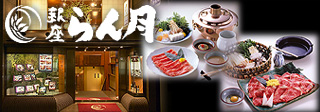
Visit Architecture
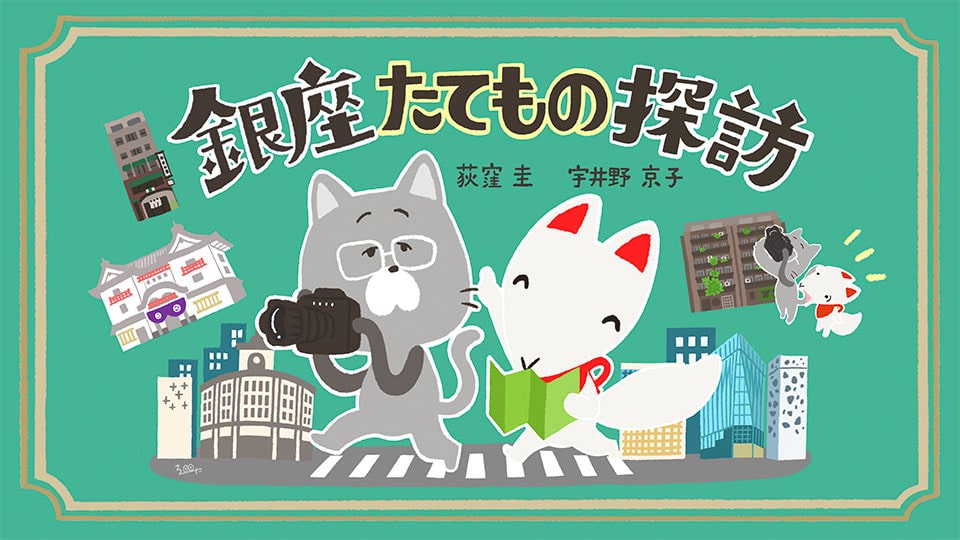
Exploring Ginza’s Architecture Vol. 3. Marunouchi TOEI
2025.05.15
There comes a time when a building ends its role. It is indeed a sad moment that is sometimes inevitable. Fully using a building until its last day may be the best way to appreciate it.
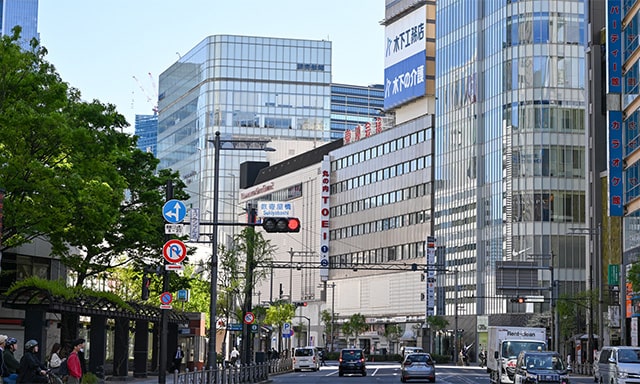
- Uino
- Ogikubo san, in this edition of “Exploring Ginza’s Archnitecture”, we will visit TOEI Kaikan (Marunouchi TOEI)
- Ogikubo
- Marunouchi TOEI is that movie theater on Sotobori-dori that we can see from the Sukiyabashi Intersection. I don’t recall anything special about it.
- Uino
- I wanted to visit it before it closes in July this year for reconstruction.
- Ogikubo
- So this is a special edition to appreciate a building that we will be losing soon.
- Uino
- Let us keep it in our records and memory.
- Ogikubo
- The building has always been there and I had never thought about how old it was. Is it so old that it needs to be rebuilt?
- Uino
- It was built in 1960 (Showa 3).
- Ogikubo
- That far back! That is three years before I was born. It had never occurred to me that it was such an old building, but come to think of it, the façade and windows do have a Showa look.
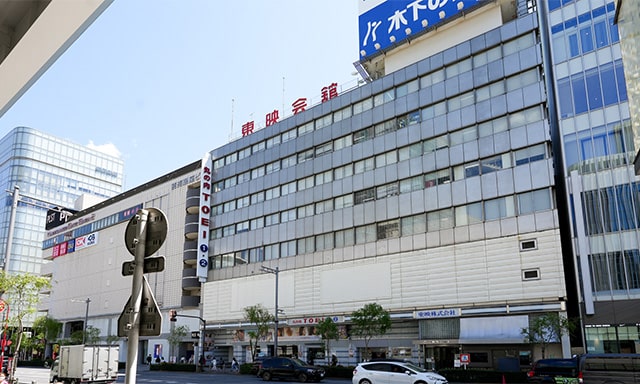
A part of the townscape, it does not seem to be 65 years old.
- Uino
- Don’ you find this intriguing?
- Ogikubo
- I do, I do. 1960 marks the beginning of Japan’s period of rapid economic growth—the golden age when movies were king of entertainment. I’m curious what movie theaters were like back then. How much remains from back then?
- Uino
- That is what we are here to find out!
A movie theater that lets you relive the high-growth era
- Uino
- So here we are at the Toei Kaikan, where we’ve been given a thorough tour and heard many stories from the old days. There’s so much to cover, I don’t even know where to begin. Any suggestions?
- Ogikubo
- I’d like to start by clearing up a basic question that’s always puzzled me.
- Uino
- Any what may that be?
- Ogikubo
- The Toei Kaikan is in Ginza 3-chome, yet it’s called “Marunouchi TOEI.” The name Marunouchi gives one the impression that it would be located on the other side of the JR train tracks. Technically, Marunouchi is the area on the inner side of the metropolitan expressway KK Line (which follows the path of the old inner moat), but Toei Kaikan is clearly on the outside.
- Uino
- Ah, the name. According to people at Toei, it may be because there used to be a bridge called “Marunouchi-bashi” (Marunouchi Bridge) in front of the theater, and several movie theaters with “Marunouchi” in their names were located on the other side.
- Ogikubo
- I wasn’t quite convinced about that, so I checked it out. I had a map of Chuo-ku from 1953 (Showa 28)—right after the Second World War, before the Toei Kaikan was built—and took a look. And guess what?
- Uino
- What did you find?
- Ogikubo
- There was a bridge called “Marunouchi-bashi” right next to where the Toei Kaikan now stands! It must have meant “the bridge leading to Marunouchi.” The Marunouchi Piccadilly is located on the inner side and there used to be the Marunouchi Nikkatsu and Marunouchi Toho as well. So the name “Marunouchi TOEI” totally makes sense.
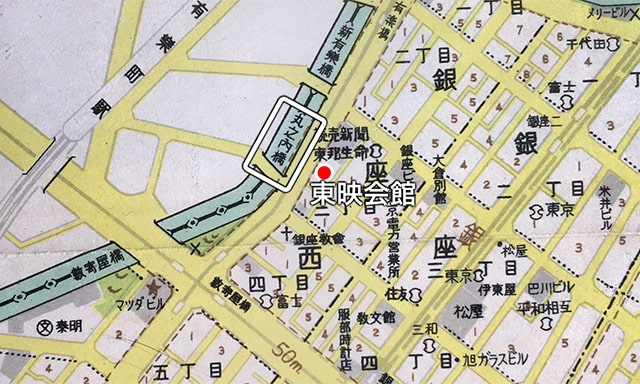
The inner moat was still intact, and the Marunouchi Bridge is clearly marked!ま
(“Chuo-ku” from Tokyo Wards: Detailed Maps, published by Nitchi Shuppan. Courtesy of Kei Ogikubo.)
- Uino
- Now that the mystery is solved, let’s dive into the glamour of the heart of entertainment from the high-growth era.
- Ogikubo
- The lobby has a nostalgic structure!
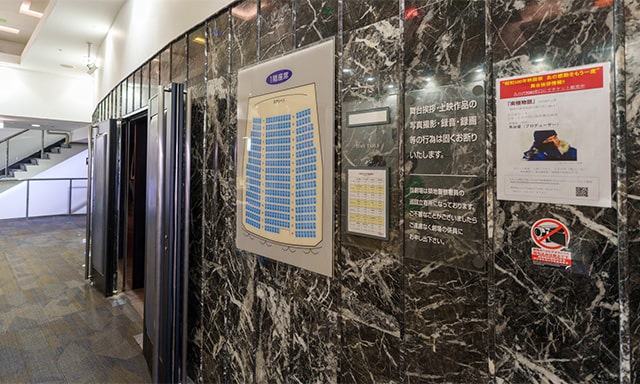
Even the seating chart feels nostalgic.
- Uino
- What do you mean by nostalgic?
- Ogikubo
- Most theaters nowadays are multiplexes. There’s a large shared lobby for multiple theaters where snacks and drinks are sold. There are benches and sofas where you wait until your movie is about to start and then proceed to the theater. But back in those days, each theater had a single entrance, and once you bought your ticket and entered, you were right at the theater doors.
- Uino
- I see. So you would see the movie poster outside and be excited, “Oh! Ken Takakura is in this one!” The you would buy a ticket, hand it to the usher, and head straight to your seat. Simple, but this kind of access to the theater built up the excitement. There is only a small snack counter that is labeled “concession.” It seems to be that the word “concession” is used for snack stands in movie theaters, but what does it mean?
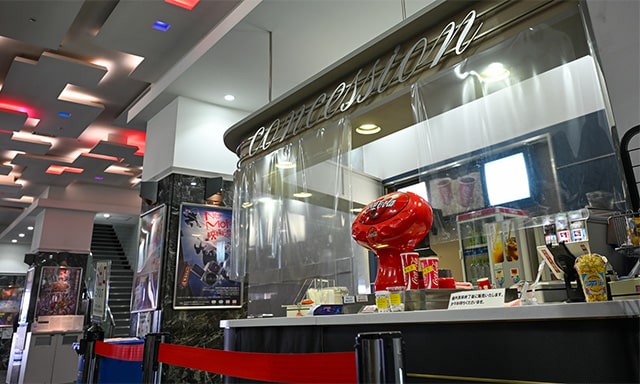
This is where one purchases drinks and popcorn.
- Ogikubo
- I was curious too so looked it up. “Concession” means “permission” or “license,” so a “concession stand” is a shop that has been given permission to operate in the theater.
- Uino
- Wow, I had no idea. It has a sophisticated ring. Oh, I found a vintage detail in the lobby. Look at the lovely pictograms on the restroom signs.
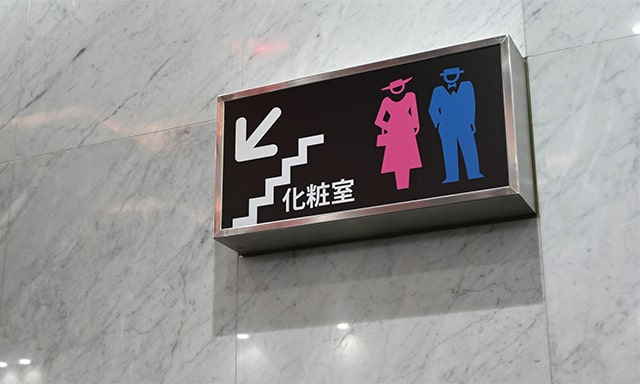
It is in the little design details where history is hidden.
- Ogikubo
- You are right. The pictograms depict a classic lady and gentleman that really evokes the theater’s old-fashioned atmosphere.
- Uino
- Now let us enter the theater. Wow, this is what I call a theater! Such a luxurious space!
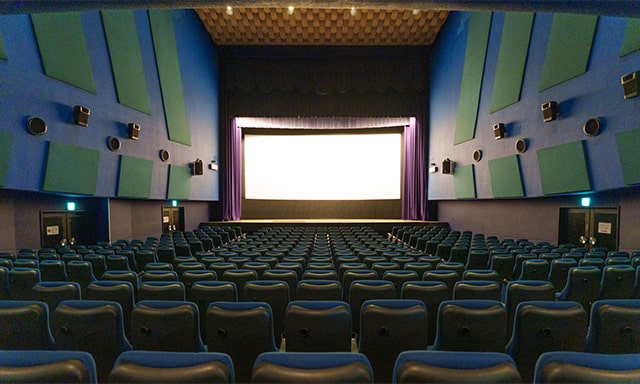
and the seats arranged on a very mild slope.
- Ogikubo
- This is classic too. Old movie theaters had doors at the back of the room. And I was surprised at the mild slope—modern cinemas have steeply inclined seating, and you look for your seat walking up from the entrance at the bottom of the steps stairs. It is like a shallow bowl.
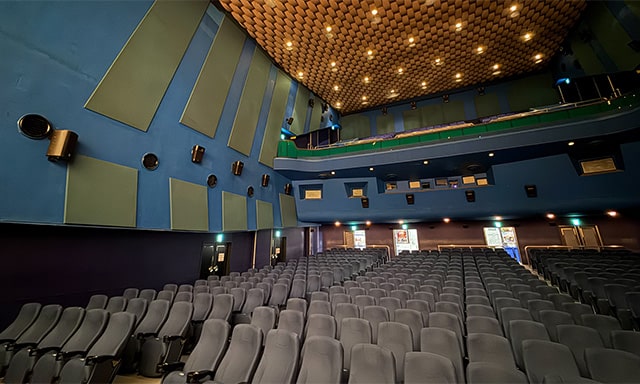
You can see the gentle slope and the angle of the seat backs clearly.
- Uino
- Yet from any seat, the screen appears perfectly in your line of sight. Apparently, even the chair angles were carefully calculated.
- Ogikubo
- It helps that the screen is up on a big stage, making it easy to see. In modern theaters, you look down at the screen.
- Uino
- And the wide stage makes it perfect for actor greetings and stage events too.
- Ogikubo
- It even has second floor balcony seats that we rarely see today. This is indeed luxurious.
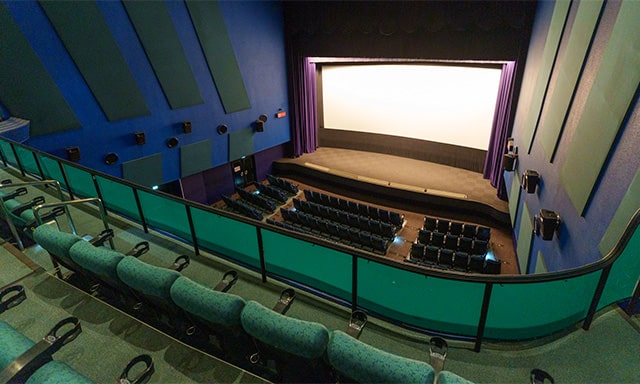
- Uino
- Those front-center balcony seats were once reserved seats, right? The seats are a bit plush. Perfect for date-nights!
- Ogikubo
- What makes this theater unique is that the upper floors are offices for Toei Company Ltd. There’s even a barbershop for employees in the building, which is open to the public.
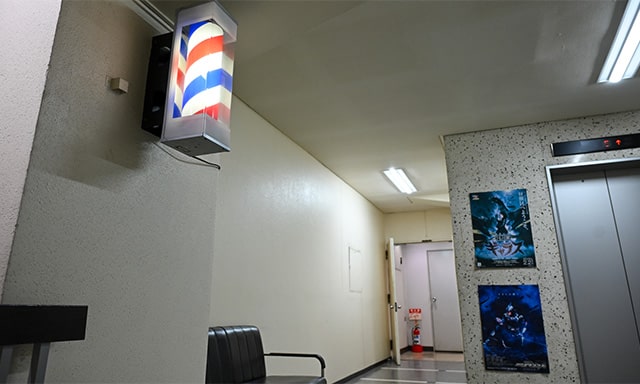
- Uino
- The owner used to run a barbershop in Ginza. A regular customer from Toei suggested he open a shop in TOEI Kaikan to make it more convenient. Therefore, he knows the area from before TOEI Kaikan was built. He said that he used to sneak in and play catch on Sundays when it was still an empty lot.
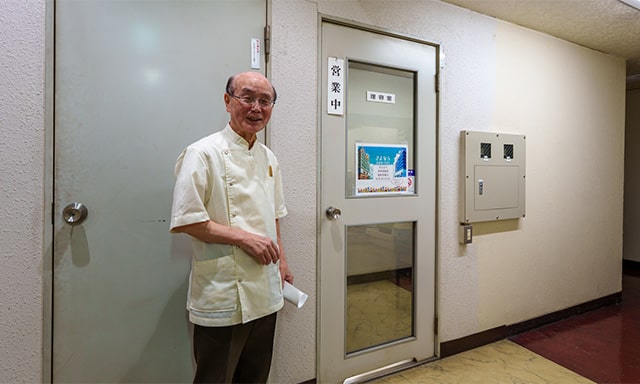
- Ogikubo
- We’ve highlighted the spots where you can still feel the vibe of when movies at the heart of entertainment. Anyone visiting Marunouchi TOEI should definitely check these out.
- Uino
- I heard there used to be a café as well. It really was a landmark venue for entertainment.
Traces of history in unexpected places
- Uino
- Now let us continue diving deeper.
- Ogikubo
- When you say deeper, you must mean areas not open to the public, where only staff and insiders can access. Those non-public areas are where you often find old equipment and hidden gems.
- Uino
- We were lucky enough to be shown the projection room.
- Ogikubo
- That wall clock in the projection booth—doesn’t it look ancient? The font is classic. It does not have the manufacturer’s logo, but it would sell for sure if they made a replica.
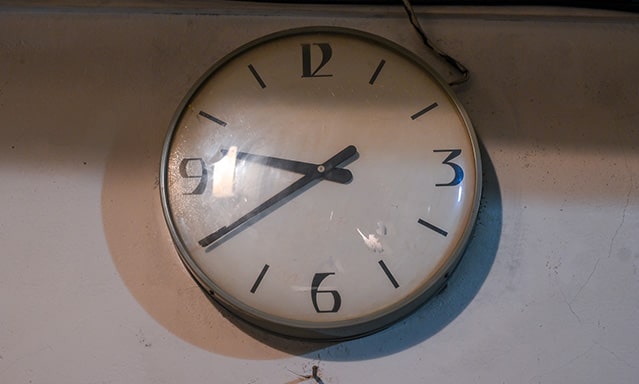
There is no brand name, yet the typeface and style of the dial unmistakably mark it as vintage.
- Uino
- The clock is fascinating too, but look at this window!
- Ogikubo
- That is the inspection window next to the projector which has not been changed from when they used film. Back then, the projectionist had to manually change reels, so they played each reel watching carefully through that window. Now the same room houses a modern digital projector. That contrast is amazing.
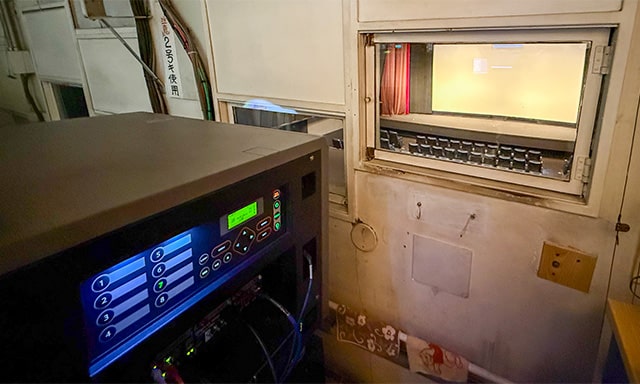
now houses a state-of-the-art digital projector—what a contrast!
- Uino
- I’m amazed they managed to get this bulky equipment through that narrow, steep stairway.
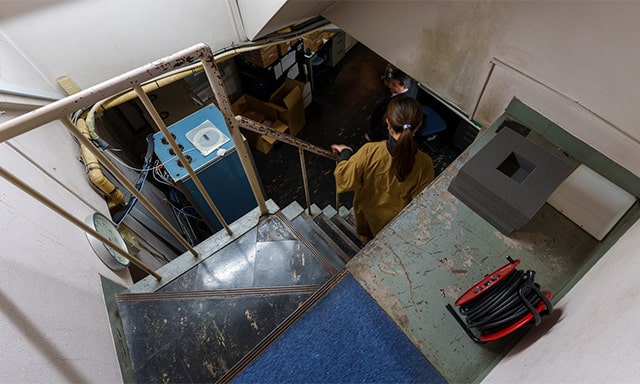
How did they bring the digital equipment in?
- Ogikubo
- The air conditioning system is also worth noting. Both film and digital equipment release a lot of heat. Did you notice the pipe running in front of the projector that they used to let water flow? They used water to cool the equipment. Imagine doing all this before air conditioning existed. Oh look, more vintage gear!
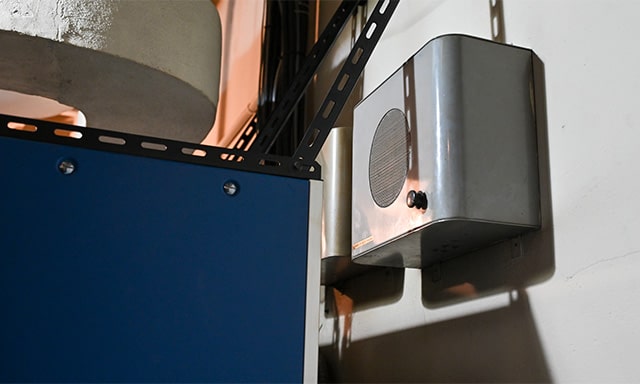
Speakers from the days of the theater’s opening
- Uino
- Those speakers were used to relay announcements from the control room. Let us look at other spots from the high-growth era. We were recommended some spots by a Toei employee who is also a Toei enthusiast.
- Ogikubo
- First, the floor numbers on the stairs. The font is beautiful, but I especially love that lightning bolt-like symbol between the numbers.
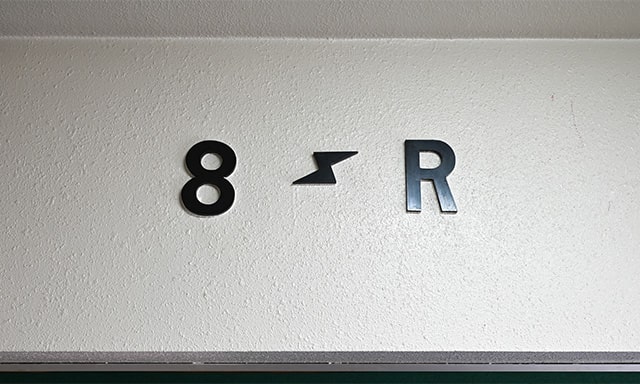
- Uino
- And the dust chute! You never see these anymore. Trash dropped here would go straight to the basement, where they had an incinerator to burn the waste onsite.

Who would have guessed there was an incinerator in the basement!
- Ogikubo
- I would have thought that they collected the trash and loaded it ont to garbage trucks, but no—they burned it in-house. That is unthinkable today.
- Uino
- They even had their own backup generator in the basement, which to my surprise had been in use until quite recently. I was also surprised to see so many “No smoking while walking” signs everywhere.
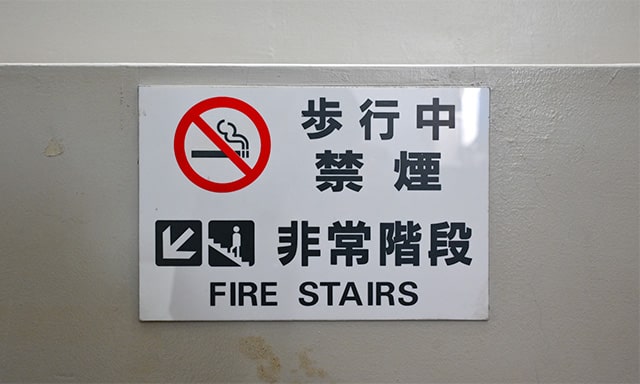
They reflect the old times when smoking indoors was normal.
They are a tangible reminder of the time passed.
- Uino
- Also worth noting are the mailboxes. Each floor had a drop slot for outgoing mail, which were all collected in a box on the first floor for postal pickup.
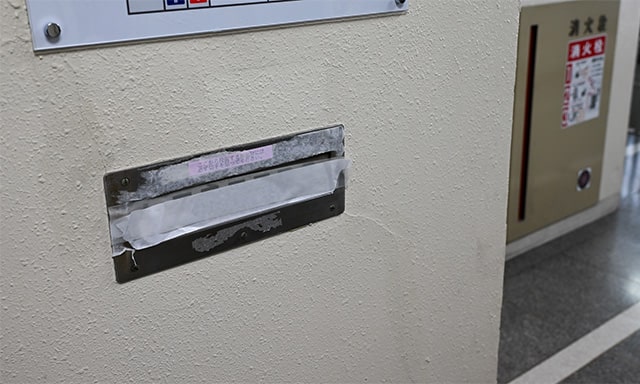
Note the label: “Please affix a stamp to mail dropped here.”
- Ogikubo
- I wondered where those mail from each floor went, and found the box at reception on the first floor. It says “Private Mailbox.” It is no longer used and is therefore taped shut, but I love that it’s still here. I think it is valuable that we can still be reminded of those old times.
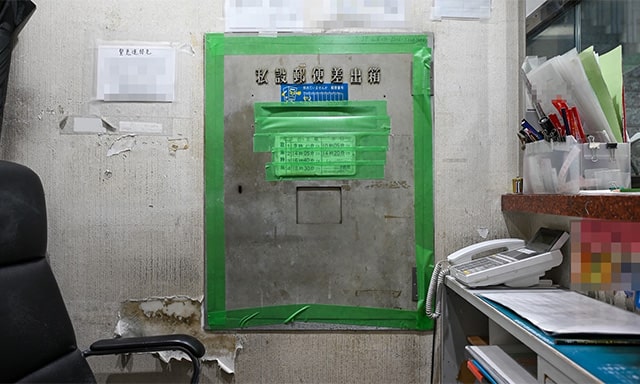
This is where the post office delivered and collected the mail.
- Uino
- Lastly, let us visit the rooftop. There’s a small Inari shrine up there.
- Ogikubo
- A surprise side-story from our “Visit Ginza’s Shrines” series.
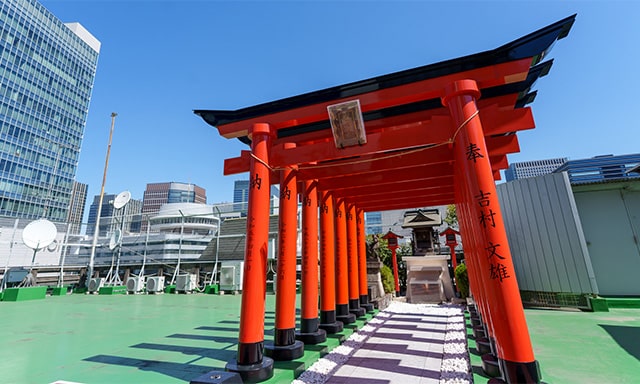
- Uino
- I was moved to discover such an impressive Inari shrine after we concluded our “Visit Ginza’s Shrines” series. It is so beautiful and powerful.
- Ogikubo
- “The plaque reads ‘Toei Inari,’ and the names of successive company presidents are inscribed on the torii gates. It may have stood here since the building was first completed. The open sky feels especially vast, thanks to the absence of tall buildings nearby.”
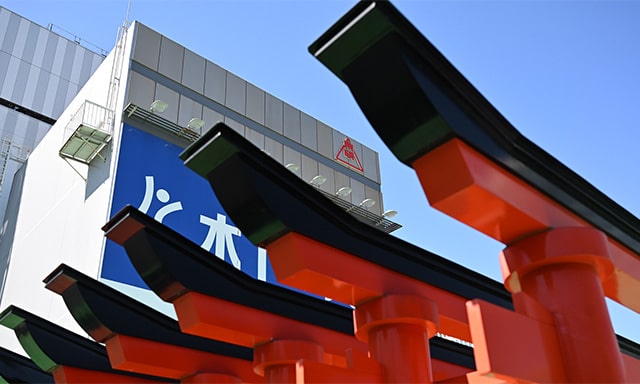
- Uino
- You can see the building from the JR railway (then Japan National Railway) so they so they used to hang large movie banners on the walls. At one time, there was even a beer garden up here.
- Ogikubo
- Amazing. Watching Battles Without Honor and Humanity and then heading to a rooftop beer garden? That sounds exciting.
- Uino
- And that wraps up our journey from basement to rooftop through this 65-year-old theater.
- Ogikubo
- At first, I was not quite sure about covering a building slated for demolition. But it turned out to be full of traces of history, and every corner was fascinating. History is not told only through famous events, but can be found in places like this. I hope that many people can come to feel the atmosphere of the theater itself, which we discussed in the first half. When will it close?
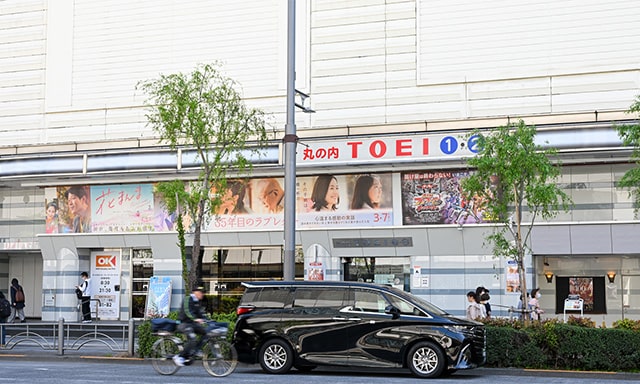
- Uino
- It closes on July 27, 2025, so there’s still time! The theater opened in September 1960, so it will close just a little before its 65th anniversary. I have already booked my ticket!
- Ogikubo
- This is a good opportunity to feel the difference between a classic movie theater from the golden age of film and today’s multiplexes. Where else can you watch the latest movies using the latest tech—inside a 65-year-old movie theater?
Modern architecture featuring cutting-edge technology design and old prewar buildings are fascinating in their own right, but there’s a unique richness in the buildings from Japan’s high-growth era that could only be created then. I hope that many people have a chance to enjoy the building before it closes.
The “Sayonara Marunouchi TOEI” project has been launched, featuring a variety of special screenings. For details, please visit:
https://marunouchi-toei-sayonara0727.jp/
All List
- 2024.11.05 Exploring Ginza’s Architecture Vol. 1 Kyobunkwan-Seishokwan Building
- 2025.02.01 Exploring Ginza’s Architecture Vol. 2 Ginza’s Police Boxes
- 2025.05.15 Exploring Ginza’s Architecture Vol. 3. Marunouchi TOEI
- 2025.08.01 Exploring Ginza’s Architecture Vol. 4 Daiichi Sugawara Building
- 2025.11.01 Exploring Ginza’s Architecture Vol.5 Ginza Church





